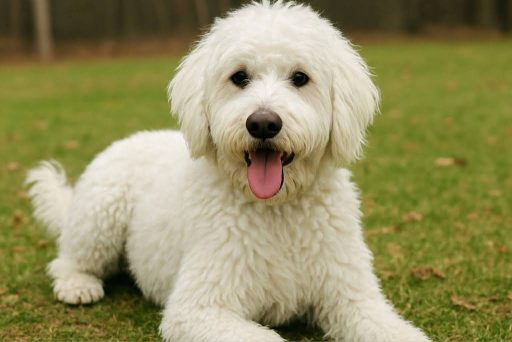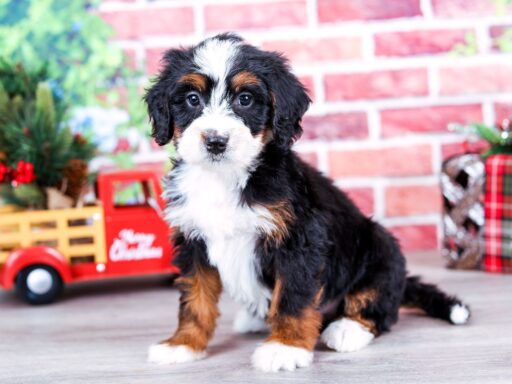White Bernedoodles have a look that’s hard to ignore; soft, fluffy coats and a gentle expression that gives them a calm, almost angelic presence. But there’s more to these dogs than just looks.
Underneath the snow-white coat is a bright, loyal, and affectionate companion that fits easily into family life. While solid white Bernedoodles are less common than traditional tricolor or merle patterns, they’ve been gaining popularity among people who want something clean and classic.
Their coats can range from pure white to soft cream or white with subtle markings, depending on the genetics behind the pairing.
In this guide, we’ll go over what makes white Bernedoodles unique, how to care for them, what to expect in terms of size and temperament, and why more families are choosing this striking variation.
Key Takeaways
✔ White Bernedoodles have a light, soft coat and a steady, affectionate personality that fits well in most homes.
✔ They come in various sizes and coat textures depending on parent pairing and generation.
✔ Most are gentle, social, and easy to train, especially with early structure and positive reinforcement.
✔ Grooming and upkeep help manage the coat and prevent tear staining, especially around the eyes and mouth.
✔ Central Illinois Doodles raises each puppy in a quiet, well-managed setting with full health testing and hands-on socialization.
What Is a White Bernedoodle?
A White Bernedoodle is a Bernedoodle with a predominantly white or cream-colored coat. The color comes from the genes passed down by the Poodle parent, since white is not a natural color in Bernese Mountain Dogs. This means white Bernedoodles typically come from pairings where the Poodle contributes more to the coat often in F1B or multigen generations.
The coat itself can vary in texture. Some have tight curls, others soft waves, and a few have straighter fleece-style coats. What they all share is a soft, light-colored coat that tends to shed very little, making them a good option for families concerned about allergies or mess.
White Bernedoodles are not albino, and they don’t have to be pure white. Some have faint cream patches or subtle phantom markings around the ears or paws. These lighter tones are part of what makes each dog look slightly different while still keeping that clean, elegant feel.

💡 Note: The white coat doesn’t change how the dog behaves or learns. It’s just one of many colors the Bernedoodle can inherit, but for some families, it’s the look they’ve been hoping to find.
White Bernedoodle Appearance and Coat Characteristics
White Bernedoodles have a soft, plush look that feels just as gentle as their personality. Their light-colored coat gives them a clean, elegant appearance that sets them apart from more common Bernedoodle colors. But there’s still plenty of variation in how they look when it comes to size and texture.
✔️ Coat Texture – Most white Bernedoodles have either a wavy fleece coat or a curlier wool coat. Both types are low-shedding, but curly coats may require more frequent brushing to stay tangle-free.
✔️ Color Shades – While some are pure white, others lean toward creamy tones or have faint tan or champagne markings. These subtle variations often become more noticeable as the puppy grows.
✔️ Facial Features – Their face usually takes after the Poodle, with a more refined muzzle and expressive, almond-shaped eyes. In some cases, you’ll see a slightly broader Bernese head shape.
✔️ Sizes – White Bernedoodles come in toy, mini, and standard sizes, depending on the Poodle parent. Toy sizes stay under 25 lbs, minis fall between 25–50 lbs, and standards can reach 90 lbs or more.
💡 Tip: Lighter coats may show dirt faster than darker ones, but regular brushing helps maintain that fluffy, fresh look and keeps the coat from matting underneath.

Temperament and Personality of White Bernedoodles
White Bernedoodles may look calm and delicate, but they’re packed with personality. These dogs are friendly, curious, and thrive on being part of the action. They bond quickly with their people, often following them from room to room like a shadow.
Most are easy to train and eager to please when routines are clear and consistent. They enjoy mental challenges just as much as physical play, which makes them a great fit for households that want an interactive, engaged companion.
Here’s what you can expect with most white Bernedoodles:
✔️ Easygoing Nature – They’re typically calm indoors but happy to join in on outdoor activities.
✔️ Affectionate – These dogs are social and enjoy closeness. Many love cuddling as much as playing fetch.
✔️ Quick Learners – Whether you’re teaching them basic commands or fun tricks, they respond well to praise and positive reinforcement.
✔️ Great with Families – They tend to be gentle with kids, friendly with guests, and easy to introduce to other pets.
💡 Note: Personality depends on breeding and how the puppy is raised. A white Bernedoodle from a well-structured, socialized environment will grow into a calm, confident companion, just like any well-bred dog in this line.
Grooming and Maintenance
White Bernedoodles are beautiful, but their coats need regular upkeep to stay that way. Light-colored fur can show dirt more easily, and if your dog has a curlier texture, it’s even more important to stay on top of brushing to avoid tangles and mats.
Routine grooming also helps reduce allergens and keeps their skin healthy, especially if your pup has a woolier coat that holds onto debris.
Here’s what a good grooming routine should look like:
💡 Tip: Get your puppy used to grooming early. The sooner they learn that brushes and clippers are part of the routine, the easier it’ll be to manage their coat long-term.
Health and Lifespan
White Bernedoodles are typically healthy and strong, especially when they come from responsible breeding lines. Their long-term wellness depends on genetics, early care, and how well you keep up with routine health needs at home.
Here’s what to keep in mind:
✔️ Watch for inherited conditions: Bernedoodles can be prone to hip and elbow dysplasia, thyroid issues, or certain eye conditions. That’s why good breeders test their parent dogs before any litter is planned.
✔️ Stay ahead of common sensitivities: Their floppy ears benefit from regular cleaning to avoid moisture buildup, and their skin can sometimes react to shifts in diet, grooming products, or weather changes.
✔️Support healthy growth from day one: A balanced, nutrient-rich diet can help your standard-sized White Bernedoodle maintain a healthy weight and develop strong, stable joints as they grow.
✔️ Keep vet visits consistent: Routine checkups, bloodwork, and dental cleanings are important, not just for prevention, but for catching small issues before they turn into larger ones.
🐶 With quality food, daily structure, and ongoing care, most Bernedoodles live between 12 and 16 years and enjoy life as steady, affectionate companions from puppyhood to old age.
Why Choose a White Bernedoodle?
White Bernedoodles aren’t just easy on the eyes; they’re easy to live with. These dogs offer the same dependable, affectionate personality Bernedoodles are known for, wrapped in a temperament that works well for both first-time owners and experienced dog lovers.
They’re social, responsive, and settle into routines without much fuss. They also tend to adjust quickly and find their place in the family.
Here’s why so many people choose them:
✔️ Calm but Playful – They bring steady energy without being overwhelming. A walk, a little play, and they’re ready to relax.
✔️ Family-Ready – Most do well with children, older adults, and other pets. They know how to read the room and respond with patience or playfulness.
✔️ Easy to Train – They pick up on commands quickly and actually enjoy the back-and-forth of learning.
✔️ Adaptable to Lifestyle – These dogs adjust well to various routines and environments. What they care most about is being near their people.
✔️ Reliable Companionship – Above all, you’re getting a dog that’s present, loyal, and easy to bond with. They don’t just live in the house; they become reliable companions.
How We Raise Our White Bernedoodle Puppies
At Central Illinois Doodles, raising great puppies starts long before they’re born. We’re intentional about everything, including pairing the right parent dogs, creating a clean and calm environment, and building early routines that help our pups grow into steady, well-socialized companions.
Here’s what our process looks like from the start:
✅ Health Testing Comes First – Every parent dog is tested for common hereditary conditions. We only breed dogs with strong structure, clean histories, and calm, even temperaments.
✅ Daily Socialization – From the time they open their eyes, our puppies are exposed to everyday sounds, people, and touch. We gently introduce new experiences in age-appropriate ways so they build confidence without fear.
✅ Structured, Low-Stress Environment – Our space is organized and quiet. Puppies get plenty of room to move, play, and rest, which helps them learn to self-soothe and adapt to new situations with ease.
Wrap Up
White Bernedoodles bring more than just a pretty face to the table. They’re smart, easy to live with, and naturally in tune with the people around them. In busy homes or slower-paced settings, these dogs tend to settle in quickly and form strong, lasting bonds.
At Central Illinois Doodles, we raise each puppy with care, structure, and attention to the small details. We don’t cut corners and we don’t send a puppy home until we know they’ve had the foundation to thrive in yours.
🐾 If you’ve been looking for a calm, people-loving dog that blends intelligence with steady companionship, a White Bernedoodle might be exactly what your family needs. Reach out to us today to learn more, ask questions, or start the process of bringing home your perfect puppy. We’re here to help every step of the way.
Frequently Asked Questions About White Bernedoodles
Do White Bernedoodles get tear stains more than darker coats?
Yes, tear stains are more noticeable on light-colored coats under the eyes. They’re caused by natural tear overflow and a pigment in the tears called porphyrin, which can leave reddish-brown marks on the fur. It’s a cosmetic issue, not a health concern. Gently wiping the area a few times a week with a damp cloth or pet-safe eye wipes can help prevent buildup and keep the coat looking clean.
Can the white coat change or darken as the puppy grows?
A little, yes. Some White Bernedoodles develop slight cream or champagne tones as they mature, particularly around the ears or back. It’s a subtle change and doesn’t affect coat texture or how much they shed.
Are White Bernedoodles more sensitive to the sun?
They can be. Light-colored coats and pink skin, especially around the nose and ears, can make them more prone to sun sensitivity. It’s usually not a big issue, but it’s wise to provide shade and limit their time in direct sunlight during the hottest parts of the day.
How often should I bathe a White Bernedoodle?
Every 4–6 weeks is usually enough. Since white coats show dirt more easily, quick spot cleans between full baths, like wiping paws or underbellies, can keep them looking fresh without over-washing and drying out their skin.
Are White Bernedoodles harder to find than other colors?
Yes, they’re less common than tricolor, sable, or merle Bernedoodles. If you’re set on a white coat, it’s smart to plan ahead; joining a waitlist or reaching out before litters are posted gives you a better chance of finding the right pup.


